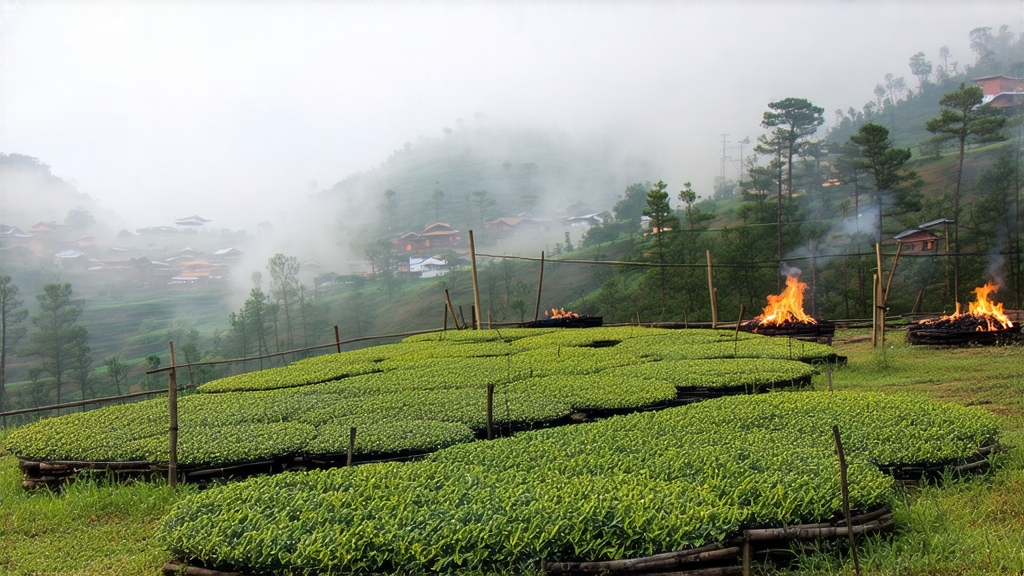
When European tea clippers first rounded the Cape of Good Hope in the mid-seventeenth century, the fragrant cargo they hurried toward London was not the familiar green leaf of Cathay, but a dark, almost ebony strand that unfurled in boiling water to release a liquor the color of burgundy and an aroma never before encountered—smoke, pine, longan, and a whisper of cacao. That tea was Lapsang Souchong, today celebrated as the earliest black tea ever created and the prototype for every subsequent red-black infusion from Assam to Ceylon. Its birthplace is the Wuyi massif in northern Fujian, a UNESCO dual heritage site where basalt cliffs plunge into the Nine-Bend River and morning mists linger long enough to bathe the tea gardens in 80 % humidity. Locals call the variety zhengshan xiaozhong—“small-leaf of the original mountain”—to distinguish it from copies made beyond the gorge. The word “lapsang” itself is a romanization of lao (pine) and xiang (fragrance), a nod to the resinous fuel that once defined its character.
History
Legend fixes the invention at 1646, when Qing troops pressed through the mountain passes and terrified tea workers rushed the leaf through withering and drying. To mask the bruised green odor they fired the baskets over fresh pine logs; the Europeans, already enamored of Wuyi oolongs, found the smoky novelty irresistible. By 1669 the British East India Company listed “Bohea Souchong” among its most valuable lots, priced higher than musk or silk. The Boston Tea Party chests that splintered on Griffin’s Wharf in 1773 were largely Lapsang; the leaf that launched a revolution was thus also the leaf that financed the imperial cups of Georgian drawing rooms. When the British later transplanted Camellia sinensis to India they carried Lapsang seeds, hoping to reproduce the magic, but the Himalaya could not supply the same pine smoke, and the clone mutated into the maltier Assamica we know today.
Cultivars within Lapsang
Although Western vendors often speak of a single “Lapsang,” connoisseurs recognize three micro-cultivars tied to elevation and mineral soil. Wuyi Caixia (“Sunset Glow”) grows at 800 m on purple sandstone; its leaf is narrow, almost needle-like, and yields a bright crimson cup with a sugared plum finish. Tongmu Guapian (“Melon Seed”) flourishes beneath a canopy of masson pines at 1 200 m; the trees drip resin onto the bushes, naturally scenting the leaf and reducing the need for heavy smoking. The rarest is Jiulongke (“Nine-Dragon Guest”), a semi-wild shrub clinging to cliff crevices at 1 500 m; pickers descend on rope ladders to collect the tiny spring shoots, which are withered only by mountain breeze and offer a whisper of smoke more reminiscent of lapsang’s aristocratic past than of today’s export commodity.
Crafting the Leaf
Plucking begins on Qingming festival morning when the standard is “two leaves and a bud, still closed like a sparrow’s tongue.” The baskets must reach the village workshop within two hours; any delay oxidizes the leaf prematurely and dulls the final sweetness. Indoor withering follows on bamboo racks above smoldering pine embers kept at 28 °C; the tea master fluffs the leaf every twenty minutes so that moisture exits evenly and the cellular membranes begin to fracture. Rolling comes next, a 45-minute rhythmic press-twist motion that bruises the edges and releases polyphenol oxidase; the leaf darkens from jade to copper within minutes. Oxidation is arrested not by baking but by rolling the leaf into iron woks lined with fresh pine bark; the temperature spikes to 90 °C for ninety seconds, caramelizing sugars and locking in the signature pinewood note. Finally the tea is slow-smoked for six to eight hours in a loft above pinewood fires whose resin content is measured by tapping the trunk: if the sap beads like honey, the wood is reserved for the final hour, imparting a clean, sweet smoke rather than the acrid pitch that plagues cheaper versions.
Grades & Market Forms
Traditional zhengshan is sold unsmoked as well, a secret kept by locals who prefer the natural honey aroma. Western buyers, however, associate the tea with